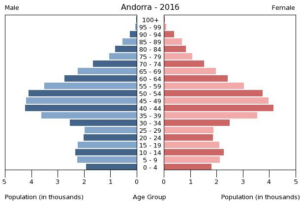Simon Kuznets, a renowned American economist, once said there are 4 economies in the world. Developed nations, developing nations, Argentina and Japan.
Well, there might just be the need for a 5th category: Andorra’s, or at least a category for micro-nations.
Andorra’s Inflation and GDP numbers for 2022
Andorra’s current GDP growth is far outpacing its Eurozone peers, its inflation is also below its Eurozone peers. Taking the Eurozone’s May 2022’s annual inflation numbers, the average inflation in the Eurozone countries was 8.1% (source). Andorra‘s, on the other hand, was 6.6%. Of course, none of these numbers are ideal. Inflation, as a whole, reflects not only the increase in money supply (as pictured below, Euro Area’s M1 Money Supply) but is also affected by supply line disruptions, increases in demand or the generic increase in commodity pricing – currently, we are witnessing all of the above. As you must be well aware by now, the prime outlier feeding inflation numbers since the end of last year has been energy costs. Regardless, above normal inflation was impossible to avoid merely due to the M1 & M2 money supplies increasing due to the governmental responses during the Covid pandemic.
source: tradingeconomics.com
Andorra’s GDP paints a far brighter picture than the above paragraphs. The Eurozone’s GDP growth in 2022 is predicted to be of 2.7% (source). Meanwhile, Andorra is boasting a GDP growth of 7.2% (source) even after a revision that lowered it.
What does this mean for you ?
By moving to Andorra, you are joining a country that is growing far faster than its peers, at least currently. The Andorran economy as a whole is vastly different from its economy 60 years ago, in fact it is not recognisable at all. Due to Andorra’s relatively small size, increases in GDP can actually be observed far more realistically than the typical increases in GDP in a country of, for example, 60 million inhabitants.
GDP growth is the inherent proof that business is thriving and therefore, opportunities arise in environments such as Andorra’s. By joining a thriving country instead of a declining one, you are creating an environment that is not only extremely advantageous when it comes to tax levels and brackets, but also very advantageous when it comes to the opportunities of doing business.
History and summary of Andorra’s current economy
Andorra’s current economy has gone through several defined phases. The origins of its modern economy can be pointed to 1950, when the General Council created the National Tourist Department. In the following year, this department became a “Syndicate of Initiative”. Tourism in general, as well as commercial tourism, had become a new industry for the relatively poor country at the time. Tourism as a whole became Andorra’s leading industry sector and in fact, remains so today.
In 1990, an agreement was signed between Andorra’s government, lead by Oscar Ribas and the ECC. This agreement stipulated the definition and arrangement of customs between Andorra and the ECC. Most items are exempt from import taxes, excepting agricultural products. Alcohol and tobacco had their own special category. In practice, it meant that Andorra kept its position as a duty-free location to purchase goods. Regulations ultimately limited the amount of goods that foreigners could take out of the country. For example, the limit for alcohol was, in 2008’s ratification, 1.5L of 22º alcohol, 1kg of coffee, 175 EUR worth of food items…
Andorra, with its “tax haven” category, both in matters of banking secrecy and in matters of tax incentives, created a huge difference compared to the European average which sprung the consolidation of several Andorran banks and made the Finance sector a major part of Andorra’s economy, after tourism.
Following the accusation of money laundering to the B.P.A. (Banca Privada d’Andorra), Andorra’s finance sector came into very significant international scrutiny. Pressures from the OECD and EU pushed Andorra to add substantial regulation to its banking sector, substantially altering its previously very advantageous bank secrecy conditions. For example, EUR transfers out of Andorra are manually scrutinized.
Talking about Euros, as you may know it is Andorra’s currency. In June 2011, the EU and Andorra reached an agreement that allowed official use of the currency – despite Andorra using the Euro since 2002 due to the replacement of the Spanish Peseta, the currency it had been using until that point. The agreement also allowed Andorra to mint its own Euro coins, which come with Andorran imagery.
Since it is not part of the EU, it does not have de jure weight on economical decisions and policy despite using the Euro. As such, it is a direct subject of the ECB’s economical policy, similarly to other European micro-states: the Vatican, San Marino & Monaco.
In conclusion, Andorra’s economy relies, by order of importance on the services sector, representing 94.9% of its GDP; industry, representing 4.7% of its GDP; agriculture, representing 0.4% of its GDP. Within the services sector, tourism is the prime sector alongside financial services. In manufacturing, furniture and tobacco are the two outstanding sectors. In agriculture, the raising of sheep and cattle (particularly for its beef, a historical exportation) are the main sectors.
Andorra’s GDP numbers, from 1970 to 2020
source: tradingeconomics.com
Andorra’s population

Unlike other Western countries whose populations are projected to decline, mostly due to declining birthrates in the native populations, Andorra’s population is already declining when looking at births to deaths. Its demographic pyramid is also consistent to its western peers. As a result, governmental policy has been attempting to increase Andorra’s population through immigration, particularly of young European adults to help stabilize Andorra’s demographical future.
One may notice a small gap of ages 20 to 30 which is mostly a social factor. When an individual reaches the age of 18, most decide to pursue studies. Andorra, as a small country, does not possess huge universities or world-renowned campuses. Due to this, students emigrate away to study at a University of their choice. Often, they might also stay to gain work experience and return to Andorra at a later date, assuming they decide to return. Overall, Andorra is not the best country in Europe for the employees in general for several reasons. In fact, in our first article, we highlight which personas we believe are the best suited to Come To Andorra.
While our article didn’t specify which personas are susceptible to worse conditions than before they moved, employees definitely possess this risk. The two main reasons for this phenomena are the following:
- Housing costs: A rent or mortgage payments are going to be your nº1 spending in Andorra. What’s the natural consequence of many high-earning entrepreneurs concentrated in a geographical area that is sparsely built, not the easiest to physically reach and whose landscape is primarily mountainous and alpine ? You get high real-estate prices.
- Low wages: Andorra’s minimum wage is considerably smaller than France’s 1603€, and sits in line with Spain’s 1.126€ (965€ a month, paid 14 times). Andorra’s minimum wage sits at 1,121.47€/month as of 2021.
The problem herein is that these Andorran wages do not account for the far higher real estate prices. In Andorra, you need a minimum of ~1200 to 1400€/month to afford all necessities, whereas this figure is far lower in Spain and France. Thus, to live by oneself earning only minimum wage while paying for rent and typical necessities isn’t enough to get by.


